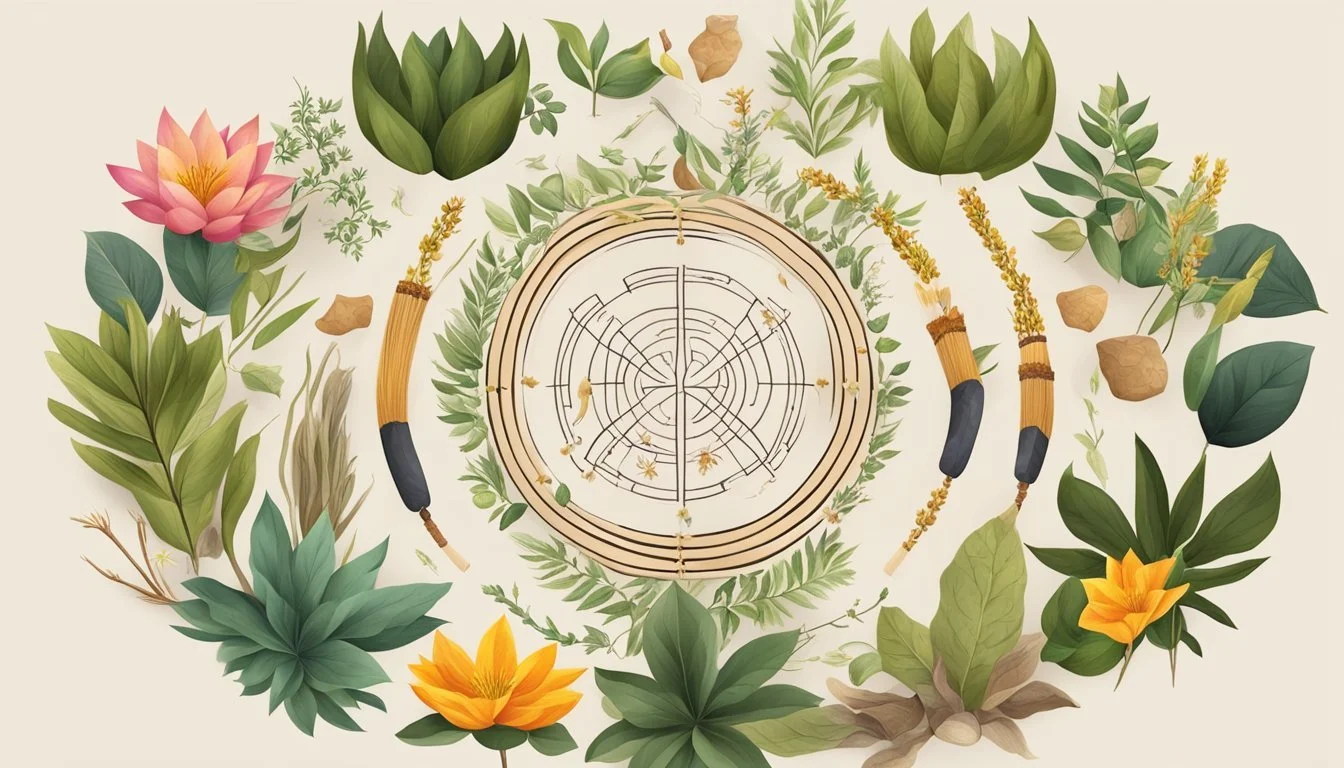7 Sacred Plants Used in Spiritual Rituals Worldwide
Ancient Traditions Revealed
Throughout history, humans have revered certain plants for their spiritual and medicinal properties. These sacred plants play important roles in religious ceremonies, healing rituals, and cultural traditions across the globe. From ancient civilizations to modern indigenous societies, people have turned to nature to connect with the divine and access altered states of consciousness.
Sacred plants serve as bridges between the physical and spiritual realms in many belief systems. Some are used for purification and cleansing, while others are ingested to induce visions or facilitate communication with the spirit world. The specific plants considered sacred vary between cultures, but common examples include sage, tobacco, peyote, ayahuasca, and lotus. Understanding the significance of these plants provides insight into diverse spiritual practices and humanity's enduring relationship with the natural world.
1) Ayahuasca
Ayahuasca is a sacred plant medicine native to the Amazon rainforest. It has been used for centuries by indigenous tribes in South America for spiritual and healing purposes.
The brew is typically made from two main ingredients: the Banisteriopsis caapi vine and leaves of the Psychotria viridis shrub. These plants contain powerful psychoactive compounds that produce intense visions and altered states of consciousness.
Ayahuasca ceremonies are led by experienced shamans who guide participants through the spiritual journey. The rituals often take place at night and can last several hours.
Users report profound spiritual experiences, deep personal insights, and emotional healing during ayahuasca sessions. Many describe encounters with spirit entities or accessing higher realms of consciousness.
In recent years, ayahuasca has gained popularity outside its traditional context. Retreat centers offering ceremonies have opened in countries like Peru, Ecuador, and Brazil.
While some seek ayahuasca for personal growth, it's important to note that the brew can have intense physical and psychological effects. Proper screening and experienced guidance are essential for safe use of this potent plant medicine.
2) Peyote
Peyote, a small cactus native to Mexico and the southwestern United States, has been used for centuries in Native American spiritual practices. This plant contains mescaline, a psychoactive compound that induces altered states of consciousness.
Many indigenous tribes, including the Navajo and various Apache groups, consider peyote a sacred medicine. They use it in ceremonial rituals to facilitate spiritual growth, healing, and connection with the divine.
Peyote ceremonies are deeply meaningful events that bring communities together. Participants consume the cactus under the guidance of experienced elders or spiritual leaders. The plant is believed to open doors of perception, allowing individuals to receive spiritual insights and messages.
These rituals often involve prayer, meditation, and the use of traditional musical instruments. The visions and experiences during peyote ceremonies are interpreted as sacred communications from higher powers.
For many Native American groups, peyote use is not only spiritual but also serves as a way to preserve cultural identity and strengthen communal bonds. The plant's significance extends beyond individual experiences to encompass broader themes of tradition and heritage.
3) Iboga
Iboga is a sacred plant deeply rooted in Central African spiritual traditions, particularly in Gabon. The shrub belongs to the Apocynaceae family and is native to the Congo basin region.
The root bark of Tabernanthe iboga contains powerful alkaloids, including ibogaine. This psychoactive substance is central to its use in spiritual ceremonies and healing rituals.
In Bwiti religious practices, iboga plays a crucial role. Practitioners brew the root bark into a tea for ceremonial consumption. The plant is believed to facilitate connections with the divine realm and ancestral spirits.
Iboga ceremonies are considered transformative experiences. Participants often report heightened awareness, introspection, and profound spiritual insights. The rituals are typically conducted under the guidance of experienced shamans or spiritual leaders.
Beyond its spiritual applications, iboga has garnered attention for its potential therapeutic properties. Some researchers are exploring its use in treating addiction and mental health disorders.
It's important to note that iboga is a potent substance with significant effects on the mind and body. Its use should only occur in appropriate cultural contexts or under professional medical supervision.
4) Sage
Sage holds profound spiritual significance across many cultures, particularly in Native American traditions. This aromatic herb is widely used in smudging ceremonies to purify spaces and individuals.
The practice of burning sage, known as smudging, is believed to cleanse negative energies and promote healing. Many Native American tribes use sage in rituals to carry prayers to the spirit world and invoke protection from harmful influences.
Sage is also utilized in various healing practices. Its scent is thought to promote emotional well-being and spiritual clarity. Some traditions incorporate sage in medicinal preparations to treat physical ailments as well.
In modern spiritual practices, sage has gained popularity for its perceived ability to clear stagnant energy from homes and workplaces. Many people burn sage before meditation or yoga sessions to create a sacred atmosphere.
The use of sage extends beyond North America. Some European cultures have historically used sage in their own spiritual and medicinal practices, highlighting its widespread recognition as a plant with sacred properties.
5) Coca
The coca plant holds deep spiritual significance in Andean cultures, particularly among the Inca civilization. Native to South America, its leaves have been used in religious rituals for centuries.
Coca leaves were considered a divine gift and played a central role in Inca ceremonies. The plant was believed to connect people with the spirit world and was often offered as a sacrifice to deities.
In traditional Andean practices, coca leaves are still used in spiritual rituals today. One notable ceremony is the Pachamama (Mother Earth) ritual, where three coca leaves are buried to represent different spiritual levels and seek good fortune.
The leaves are also used in divination practices and as a means of communicating with spiritual realms. Shamans and spiritual leaders chew the leaves to induce visions or enhance their connection to the divine.
Despite its sacred status, coca has faced controversy due to its association with cocaine production. However, its traditional spiritual uses remain an important part of Andean culture and identity.
6) Kava
Kava, derived from the Piper methysticum plant, holds a sacred place in Pacific Island cultures. This shrub, native to the South Pacific, has been used for centuries in traditional rituals and ceremonies.
In Tonga and other Pacific nations, kava plays a central role in social and spiritual practices. The plant is believed to foster communion, balance, and empathy among participants in kava ceremonies.
Kava consumption is deeply rooted in Pacific Island traditions, with its use dating back thousands of years. The plant is often considered a bridge between the physical and spiritual realms, allowing users to connect with ancestral spirits.
During important gatherings and rituals, kava is prepared and shared among community members. The ceremony surrounding its consumption helps strengthen social bonds and mark significant occasions.
Beyond its spiritual significance, kava has been used for medicinal purposes in traditional Pacific Island healing practices. The plant is believed to possess calming properties and has been used to treat various ailments.
7) Basilisk Vine
Basilisk vine, scientifically known as Cissus quadrangularis, is a perennial plant native to Africa and Asia. This sacred plant has been used for centuries in traditional medicine and spiritual practices across various cultures.
In Ayurvedic medicine, basilisk vine is revered for its healing properties. It is believed to promote bone health, aid in digestion, and reduce inflammation. Many practitioners incorporate it into herbal remedies and tonics.
Some indigenous communities in Africa use basilisk vine in spiritual rituals and ceremonies. The plant is thought to possess protective qualities and is sometimes used in cleansing rituals to ward off negative energies.
Basilisk vine has unique square-shaped stems, which give it a distinctive appearance. This characteristic has led to its use in symbolic representations in some spiritual traditions.
While not as well-known as other sacred plants, basilisk vine continues to play a role in both traditional medicine and spiritual practices. Its use demonstrates the enduring connection between plant life and human spirituality across different cultures.
Historical Significance of Sacred Plants
Sacred plants have played a pivotal role in spiritual practices throughout human history. Their use spans ancient civilizations to modern spiritual traditions, shaping rituals and belief systems across cultures.
Ancient Civilizations and Their Practices
In ancient Egypt, the blue lotus held great spiritual importance. Priests used it in religious ceremonies and as offerings to the gods. The Aztecs revered peyote, believing it connected them to the divine realm.
Ancient Greeks incorporated laurel into their rituals. Priestesses at the Oracle of Delphi chewed laurel leaves to induce prophetic visions. In India, the use of soma, a plant-based substance mentioned in Vedic texts, was central to religious ceremonies.
Mayans utilized sacred plants like tobacco in their rituals. They believed the smoke carried their prayers to the gods. The ancient Celts regarded mistletoe as a powerful spiritual plant, using it in healing practices and fertility rites.
Sacred Plants in Modern Spirituality
Many indigenous cultures continue to use sacred plants in their spiritual practices. Ayahuasca ceremonies in the Amazon basin involve consuming a brew made from the ayahuasca vine and chacruna leaves.
Peyote remains significant in Native American Church rituals. Members partake in the cactus during all-night ceremonies for healing and spiritual guidance.
In modern Wiccan and neo-pagan traditions, herbs like sage and rosemary are used for cleansing and protection. Burning sage, known as smudging, is a common practice for purifying spaces.
Some Buddhist traditions incorporate the use of incense made from sacred plants in meditation and devotional practices. This aids in creating a focused, spiritual atmosphere.
Cultural Practices and Traditions
Sacred plants play vital roles in spiritual rituals across diverse cultures worldwide. Their use varies significantly based on indigenous beliefs, geographical locations, and longstanding traditions. Specific plants hold deep symbolic meaning and are carefully incorporated into ceremonies and healing practices.
Indigenous Rituals
Many indigenous cultures incorporate sacred plants into important rituals and ceremonies. Peyote, a small cactus native to Mexico and the southwestern United States, is central to rituals of the Native American Church. Members consume peyote to induce visions and connect with the divine.
Ayahuasca, a brew made from Banisteriopsis caapi vine and other plants, is used in spiritual ceremonies by Amazonian tribes. Shamans guide participants through intense visionary experiences believed to provide healing and enlightenment.
Sweetgrass is burned as incense in purification rituals by various Native American tribes. Its sweet aroma is thought to attract positive energies and carry prayers to the spirit world.
Regional Variations in Spiritual Use
The use of sacred plants varies widely across different regions and spiritual traditions. In India, tulsi (holy basil) is revered in Hinduism as a manifestation of the goddess Lakshmi. Devotees grow tulsi plants in their homes and use the leaves in daily worship and medicinal preparations.
In Central and South America, coca leaves are chewed or brewed into tea for ritual purposes. Indigenous Andean cultures use coca to combat altitude sickness and as an offering to Pachamama, the Earth goddess.
Frankincense and myrrh, aromatic tree resins, have been used in religious ceremonies across the Middle East and North Africa for thousands of years. They are burned as incense in Christian, Islamic, and Jewish rituals.






